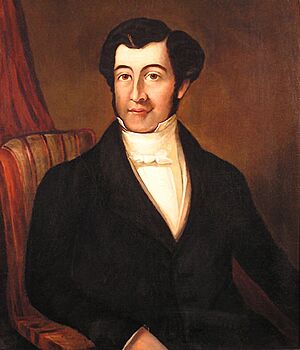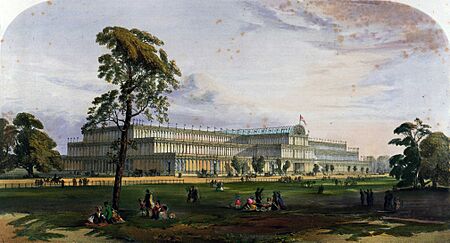Joseph Bramah facts for kids
Quick facts for kids
Joseph Bramah
|
|
|---|---|
 |
|
| Born | 13 April 1748 |
| Died | 9 December 1814 (aged 66) |
| Nationality | English |
| Known for | hydraulic press |
Joseph Bramah (born April 13, 1748 – died December 9, 1814) was a clever English inventor and locksmith. He is famous for making the flush toilet better and for inventing the amazing hydraulic press. He is also known as one of the main founders of hydraulic engineering, which is about using liquids to create power.
Contents
Growing Up: Joseph Bramah
Joseph Bramah was born in 1748 in England. He was the second son of a farmer named Joseph Bramma and his wife, Mary Denton. He went to school in a town called Silkstone. After school, he became an apprentice to a local carpenter. This means he learned the trade by working for an experienced carpenter.
When he finished his training, Joseph moved to London. There, he started working as a cabinet-maker. In 1783, he married Mary Lawton. They lived in London and had a daughter and four sons.
Improving the Water Closet
In London, Joseph Bramah worked for a man named Mr. Allen. They installed water closets, which are also known as toilets. These toilets were based on a design patented by Alexander Cumming in 1775.
Bramah noticed that the toilets often froze in cold weather. Mr. Allen improved the design by changing a sliding part to a hinged flap. This flap sealed the bottom of the toilet bowl better. Even though Allen improved it, Bramah got the patent for this new design in 1778. He then started making these improved toilets in his workshop in Denmark Street, St Giles.
Bramah Locks Company
After learning more about how locks work, Joseph Bramah designed his own special lock. He received a patent for it in 1784. In the same year, he started his own company, Bramah Locks, at 124 Piccadilly in London. Today, the company is still in business in Fitzrovia, London, and Romford, Essex.
The Challenge Lock
Bramah's locks were well-known because they were very hard to pick or tamper with. His company even had a famous "Challenge Lock" in their London shop window starting in 1790. A sign next to it said:
The artist who can make an instrument that will pick or open this lock shall receive 200 guineas the moment it is produced.
This challenge lasted for more than 67 years! Finally, at the Great Exhibition in 1851, an American locksmith named Alfred Charles Hobbs managed to open the lock. After some discussion about how he did it, Hobbs was given the prize. It took Hobbs about 51 hours over 16 days to open the lock.
Today, the Challenge Lock is in the Science Museum in London. If you look closely at the lock, you can see it has been rebuilt since Hobbs picked it.
Developing Machine Tools
Joseph Bramah needed very precise parts for his locks. Because of this, he spent a lot of time creating machine tools. These machines helped make manufacturing processes easier and more exact. He worked closely with Henry Maudslay, who started working in Bramah's workshop when he was just 18 years old.
Together, Bramah and Maudslay invented many new machines. These machines made it much more efficient to produce Bramah's locks. They also helped other types of manufacturing. Just before Bramah passed away, his workshops also employed Joseph Clement. Clement made important contributions to the design of lathes, which are machines used to shape materials.
The Hydraulic Press
Bramah's most important invention was the hydraulic press. This machine uses Pascal's principle, which states that pressure changes evenly throughout a closed system of liquid. The press had two cylinders and pistons of different sizes. If you pushed on the smaller piston, it would create a much larger force on the bigger piston. It works a bit like a lever, increasing the force you apply. Bramah received a patent for his hydraulic press in 1795.
The hydraulic press had many uses in factories and still does today. When Bramah was developing his ideas, hydraulic engineering was a very new field. Joseph Bramah and William Armstrong, 1st Baron Armstrong were the two main pioneers in this area. The hydraulic press is still sometimes called the Bramah Press, named after its inventor.
Other Inventions
Joseph Bramah was a very busy inventor. He created many things, though not all were as famous as his hydraulic press. Some of his other inventions included:
- A beer engine (1797) for pumping beer.
- A planing machine (1802).
- A paper-making machine (1805).
- A machine that automatically printed bank notes with numbers in order (1806).
- A machine for making nibs for quill pens (1809).
He also patented the first process for making lead pipes by pushing the metal through a shaped opening. He also made machinery for creating gun stocks.
Focus on Quality
One of Bramah's biggest contributions to engineering was his strong belief in quality control. He understood that for machines to work well, their parts had to be made with much greater accuracy than was common at the time. He taught an engineer named Arthur Woolf how to machine engine parts to very close measurements. This allowed Cornish engines to use high-pressure steam, which made them much more powerful. Woolf became a leading steam engineer, and his designs were used by many others. Thanks to this focus on quality, engines that were 15 horsepower around 1800 grew to 450 horsepower by 1835. Bramah can be seen as a founding father of industrial quality control.
Death and Legacy
One of Bramah's last inventions was a special press that used water power to pull up trees. He used this machine at Holt Forest in Hampshire. While he was overseeing this work, Bramah caught a cold that turned into pneumonia. He passed away at Holt Forest on December 9, 1814. He was buried in the churchyard of St Mary's, Paddington.
The famous Brazilian Brahma beer brand is named after him. In 2006, a pub in Barnsley was opened and named "The Joseph Bramah" in his memory.
Patents
Joseph Bramah was a very active inventor. He received 18 patents for his designs between 1778 and 1812. Here are some of them:
- 1778: Flushing toilet (Patent No. 1177)
- 1784: Bramah lock (Patent No. 1430)
- 1785: Beer pump
- 1795: Hydraulic press (Patent No. 2045)
- 1798: Locks (Patent No. 2232)
- 1802: A planing machine for making gun stocks (Patent No. 2652)
- 1805: Improvements to paper manufacturing and printing (Patent No. 2840)
- 1806: Printing and numbering of banknotes (Patent No. 2957)
- 1809: Pens (Patent No. 3260)
- 1812: Public water mains and high-pressure hydraulic mains (Patent No. 3611)


